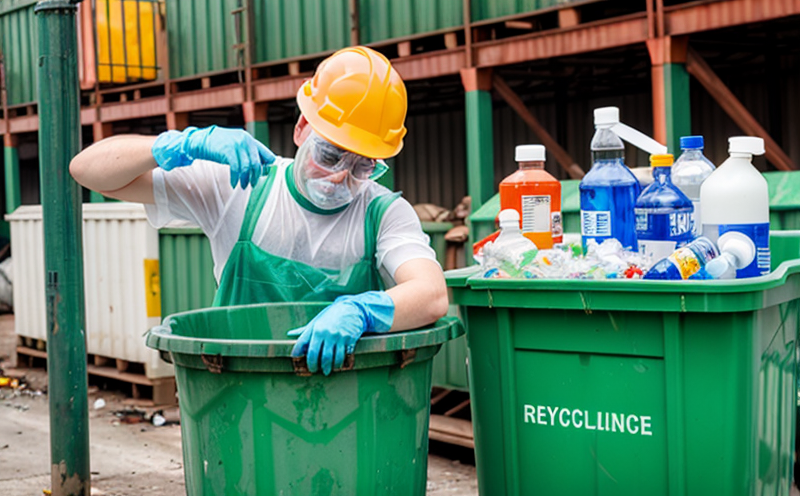DIN EN 13656 Microwave Assisted Digestion Testing of Waste
The DIN EN 13656 standard specifies a procedure for the microwave-assisted digestion of waste materials, primarily to prepare them for subsequent chemical analysis. This method is widely used in environmental testing laboratories and quality control departments to ensure accurate measurement of trace elements and metals present in solid waste samples.
This technique leverages microwave energy to rapidly heat the sample, thereby accelerating the dissolution process without significantly altering the analytes' properties or introducing contamination. The digestion step is crucial for the subsequent quantification of heavy metals, such as lead (Pb), cadmium (Cd), and chromium (Cr) in waste streams.
The procedure begins with proper specimen preparation to ensure homogeneity and representativeness. This involves crushing large particles into a fine powder using appropriate sieves or grinder equipment. The sample must then be accurately weighed, typically between 0.5g and 1g for precise analysis. After adding the required reagents, including hydrochloric acid (HCl) and hydrogen peroxide, the mixture is placed in a digestion vessel suitable for microwave irradiation.
The digestion process itself involves several steps: initial heating to activate the reagents, followed by continuous application of microwaves at controlled power levels. This step ensures thorough dissolution without causing volatilization or loss of volatile components like sulfur compounds. Upon completion, the digested solution is filtered and ready for further analysis using various instrumental techniques such as inductively coupled plasma mass spectrometry (ICP-MS).
Compliance with DIN EN 13656 is essential for ensuring accurate results that meet regulatory requirements set by environmental protection agencies. The standard provides detailed guidelines on reagent specifications, equipment calibration, and quality control measures to minimize errors in the digestion process.
The following table summarizes key aspects of the DIN EN 13656 procedure:
| Aspect | Description |
|---|---|
| Sample Preparation | Crushing, sieving, and weighing of samples. |
| Reagents Used | HCl, hydrogen peroxide, distilled water. |
| Digestion Vessel | Microwave-safe vessel with appropriate capacity. |
| Power Levels | Controlled to avoid over-digestion or loss of volatile components. |
| Filtering | Straining the digested solution through a fine filter. |
The method is designed to be robust and reproducible, making it suitable for routine analysis in both research and industrial settings. Its high efficiency and rapid processing time make it particularly valuable in waste management programs where accurate data on metal content are required.
- Ensures compliance with environmental regulations regarding heavy metals.
- Supports the development of effective recycling processes by providing precise elemental profiles.
- Aids in identifying hazardous materials that need special handling and disposal.
The accuracy of results achieved through this method can significantly influence decisions related to waste treatment, landfill management, and resource recovery projects. By adhering to DIN EN 13656, laboratories ensure their data is reliable and meets international standards for quality control.
Applied Standards
The DIN EN 13656 standard has been widely adopted internationally due to its stringent requirements and reliability. It specifies the procedure for microwave-assisted digestion of waste materials, ensuring accurate measurement of trace elements and metals.
| Standard Code | Description |
|---|---|
| DIN EN 13656:2004-11 | Method for the digestion of waste by microwave assisted heating. |
| American Chemical Society (ACS) Method | Equivalent method applicable in the United States. |
The standard is particularly useful for industries dealing with hazardous and non-hazardous solid wastes. It provides a standardized approach to sample preparation, ensuring that results are consistent across different laboratories.
- Ensures accurate measurement of trace elements and metals in waste materials.
- Supports compliance with international environmental regulations.
- Aids in identifying hazardous materials for special handling and disposal.
The use of this standard promotes best practices in the field, enhancing the reliability and accuracy of chemical analysis in waste management processes. Laboratories adhering to DIN EN 13656 can demonstrate their commitment to quality and precision in analytical work.
International Acceptance and Recognition
The DIN EN 13656 standard is widely recognized and accepted across Europe, North America, and Asia. Its rigorous methodology ensures consistent results that meet international environmental standards. This recognition enhances the credibility of test results in regulatory submissions and facilitates cross-border collaboration on waste management projects.
- European Union: Compliance with EU waste management directives.
- United States: Acceptance by state and federal agencies for hazardous waste characterization.
- China: Integration into national environmental protection regulations.
The standard's broad acceptance contributes to global efforts in managing solid waste more effectively. By ensuring uniformity in analytical techniques, it supports the development of robust waste management strategies that are essential for sustainable development.
Laboratories accredited to perform DIN EN 13656 tests can leverage this recognition to expand their service offerings and enhance their reputation among clients seeking reliable chemical analysis services.
Competitive Advantage and Market Impact
Adhering to the DIN EN 13656 standard provides significant competitive advantages in the waste management sector. It allows laboratories to offer high-quality, precise testing that meets stringent international standards, thereby enhancing their market position.
- Increased client trust due to adherence to recognized international standards.
- Potential for higher revenue through specialized services and increased business opportunities.
- Enhanced reputation among stakeholders including regulatory bodies, industry partners, and end-users.
The ability to perform DIN EN 13656-compliant tests can set laboratories apart from competitors by ensuring that their results are reliable and comparable across different regions. This capability is particularly valuable in sectors such as recycling, resource recovery, and environmental compliance where accurate data on metal content is crucial.
By embracing this standard, laboratories can also contribute to the global effort towards more efficient waste management practices, thereby aligning with broader sustainability goals. This approach fosters innovation and drives advancements in technology and methodology for better handling of solid wastes.





